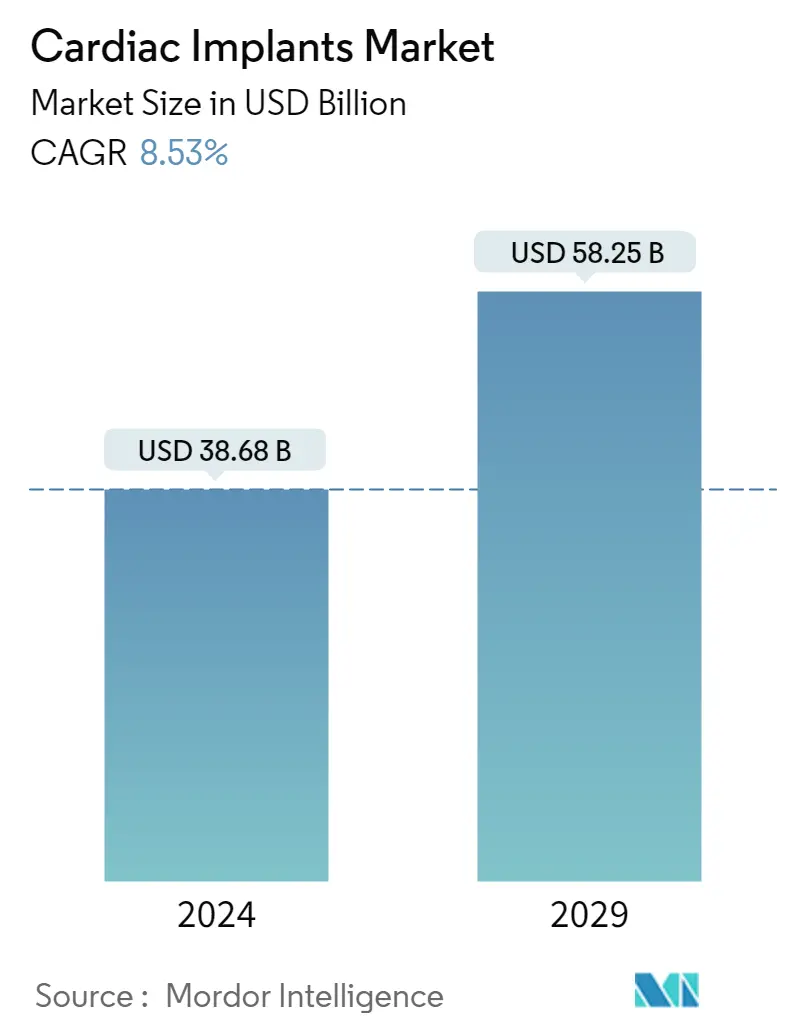Market Size of Cardiac Implants Industry

| Study Period | 2019 - 2029 |
| Market Size (2024) | USD 38.68 Billion |
| Market Size (2029) | USD 58.25 Billion |
| CAGR (2024 - 2029) | 8.53 % |
| Fastest Growing Market | Asia-Pacific |
| Largest Market | North America |
Major Players
*Disclaimer: Major Players sorted in no particular order |
Cardiac Implants Market Analysis
The Cardiac Implants Market size is estimated at USD 38.68 billion in 2024, and is expected to reach USD 58.25 billion by 2029, growing at a CAGR of 8.53% during the forecast period (2024-2029).
The COVID-19 outbreak greatly impacted every aspect of the medical device industry, including the cardiac implants devices market. The number of patient visits during the pandemic was drastically reduced, despite having access to emergency care in the cardiology department. Even the treatment proximity to infected patients with COVID-19 was a challenge for cardiologists. Access was restricted to essential care only, and the temporary closure of cardiology centers considerably reduced cardiac surgeries, as the healthcare providers were engaged with COVID-19 patients. Major players in the cardiac implant industry, such as Medtronic PLC, reported a decline in revenue of 6 billion USD in Q4 2020. But the revenue was slightly increased by 1.6 billion USD in the fiscal year 2022 compared with the fiscal year 2021. This was due to the recovery of global procedure volumes from the downturn experienced in the first and second quarters of the fiscal year 2021 as a result of the COVID-19 pandemic. Hence, the impact of COVID-19 on the market's growth was adverse in the initial phase of the outbreak, however, as surgeries and treatments have resumed worldwide, the market is anticipated to gain traction to its pre-pandemic levels in the near future.
The increase in the incidence of cardiovascular diseases and the geriatric population are the driving factors for the cardiac implants market. For instance, as per the report of the American Heart Association published in February 2022, globally, it was estimated that in 2020, 244.1 million people had ischemic heart disease (IHD), and it was more prevalent in males than in females (141.0 and 103.1 million people, respectively). Likewise, according to the Centers for Disease Control and Prevention, in June 2022 update, about 20.1 million adults aged 20 and older had coronary heart disease (CAD) in 2020 in the United States. It also stated that coronary heart disease is the most common type of heart disease in the United States. Diabetes, overweight or obesity, an unhealthy diet, physical inactivity, and excessive alcohol use were the main causes of heart disease. As a result of the increasing frequency of heart illnesses worldwide, people who are affected by them are increasingly embracing surgical procedures, including cardiac implants, which is fueling the market's growth.
In addition, advancements in technology and new product approvals and launches drive the market's growth during the study period. For instance, in October 2020, Abbott launched its new implantable cardioverter defibrillator (ICD) and cardiac resynchronization therapy defibrillator (CRT-D) devices in India for abnormal heart rhythms and heart failure.
Hence, owing to the factors mentioned above, the market is expected to witness significant growth in the future. However, the high cost of cardiac implants and the side effects associated with cardiac implants are some of the factors that may restrain the market's growth.
Cardiac Implants Industry Segmentation
As per the scope of the report, the cardiac implant is a mechanical circulatory support device that helps pump blood from the heart to the rest of the body. Cardiac implants are used for individuals with a weak heart or heart failure and diseases like atherosclerosis, congestive heart failure, coronary artery disease, hypertension, and vascular stenosis. The cardiac implants market is segmented by product (implantable cardioverter-defibrillators (ICDs), pacemakers, coronary stents, implantable heart rhythm monitors, implantable hemodynamic monitors, and other products), application (arrhythmias, acute myocardial infarction, myocardial ischemia, and other applications), end user (hospitals, cardiology centers, and other end users), and geography (North America, Europe, Asia Pacific, Middle East & Africa, and South America). The market report also covers the estimated market sizes and trends for 17 different countries across major regions, globally. The report offers the value (in USD million) for the above segments.
| By Product | |
| Implantable Cardioverter-defibrillators (ICDs) | |
| Pacemakers | |
| Coronary Stents | |
| Implantable Heart Rhythm Monitors | |
| Implantable Hemodynamic Monitors | |
| Other Products |
| By Application | |
| Arrhythmias | |
| Acute Myocardial Infarction | |
| Myocardial Ischemia | |
| Other Applications |
| By End Users | |
| Hospitals | |
| Cardiology Centers | |
| Other End Users |
| By Geography | ||||||||
| ||||||||
| ||||||||
| ||||||||
| ||||||||
|
Cardiac Implants Market Size Summary
The cardiac implants market is poised for substantial growth over the forecast period, driven by the increasing prevalence of cardiovascular diseases and a growing geriatric population. The market experienced a temporary setback due to the COVID-19 pandemic, which led to a decline in cardiac surgeries as healthcare providers focused on managing COVID-19 cases. However, as global procedure volumes have recovered, the market is expected to regain its momentum. Technological advancements and new product launches, such as Abbott's implantable cardioverter defibrillator and cardiac resynchronization therapy devices, are further propelling market expansion. Despite challenges like high costs and potential side effects, the demand for cardiac implants is expected to rise, particularly in the implantable cardioverter-defibrillators segment, due to the increasing adoption of advanced medical technologies.
North America holds a significant share of the cardiac implants market, supported by a high prevalence of cardiovascular diseases and ongoing regulatory approvals for innovative products. The region's market growth is bolstered by new product introductions and expanded indications, such as Abbott's CardioMEMS HF System and Aveir leadless pacemaker. The market is characterized by a consolidated landscape with major players like Medtronic, Boston Scientific Corporation, and Abbott leading the charge in technological advancements and competition. These companies are focusing on developing cutting-edge solutions to meet the rising demand for cardiac implants, ensuring continued market growth. As the prevalence of heart diseases increases, particularly in the United States, the market for cardiac implants is expected to expand significantly, driven by both the need for surgical interventions and the availability of advanced medical devices.
Cardiac Implants Market Size - Table of Contents
-
1. MARKET DYNAMICS
-
1.1 Market Overview
-
1.2 Market Drivers
-
1.2.1 Rising Incidence of Cardiovascular Diseases
-
1.2.2 Increase in Adoption of Torpid Lifestyle and Rising Incidence of Geriatric Population
-
1.2.3 Favourable Government Policies for Reimbursement
-
-
1.3 Market Restraints
-
1.3.1 High Cost of Cardiac Implants
-
1.3.2 Side Effects due to Cardiac Implants
-
-
1.4 Industry Attractiveness - Porter's Five Forces Analysis
-
1.4.1 Bargaining Power of Buyers/Consumers
-
1.4.2 Bargaining Power of Suppliers
-
1.4.3 Threat of New Entrants
-
1.4.4 Threat of Substitute Products
-
1.4.5 Intensity of Competitive Rivalry
-
-
-
2. MARKET SEGMENTATION (Market Size by Value - USD million)
-
2.1 By Product
-
2.1.1 Implantable Cardioverter-defibrillators (ICDs)
-
2.1.2 Pacemakers
-
2.1.3 Coronary Stents
-
2.1.4 Implantable Heart Rhythm Monitors
-
2.1.5 Implantable Hemodynamic Monitors
-
2.1.6 Other Products
-
-
2.2 By Application
-
2.2.1 Arrhythmias
-
2.2.2 Acute Myocardial Infarction
-
2.2.3 Myocardial Ischemia
-
2.2.4 Other Applications
-
-
2.3 By End Users
-
2.3.1 Hospitals
-
2.3.2 Cardiology Centers
-
2.3.3 Other End Users
-
-
2.4 By Geography
-
2.4.1 North America
-
2.4.1.1 United States
-
2.4.1.2 Canada
-
2.4.1.3 Mexico
-
-
2.4.2 Europe
-
2.4.2.1 Germany
-
2.4.2.2 United Kingdom
-
2.4.2.3 France
-
2.4.2.4 Italy
-
2.4.2.5 Spain
-
2.4.2.6 Rest of Europe
-
-
2.4.3 Asia Pacific
-
2.4.3.1 China
-
2.4.3.2 Japan
-
2.4.3.3 India
-
2.4.3.4 Australia
-
2.4.3.5 South Korea
-
2.4.3.6 Rest of Asia Pacific
-
-
2.4.4 Middle-East and Africa
-
2.4.4.1 GCC
-
2.4.4.2 South Africa
-
2.4.4.3 Rest of Middle East & Africa
-
-
2.4.5 South America
-
2.4.5.1 Brazil
-
2.4.5.2 Argentina
-
2.4.5.3 Rest of South America
-
-
-
Cardiac Implants Market Size FAQs
How big is the Cardiac Implants Market?
The Cardiac Implants Market size is expected to reach USD 38.68 billion in 2024 and grow at a CAGR of 8.53% to reach USD 58.25 billion by 2029.
What is the current Cardiac Implants Market size?
In 2024, the Cardiac Implants Market size is expected to reach USD 38.68 billion.

